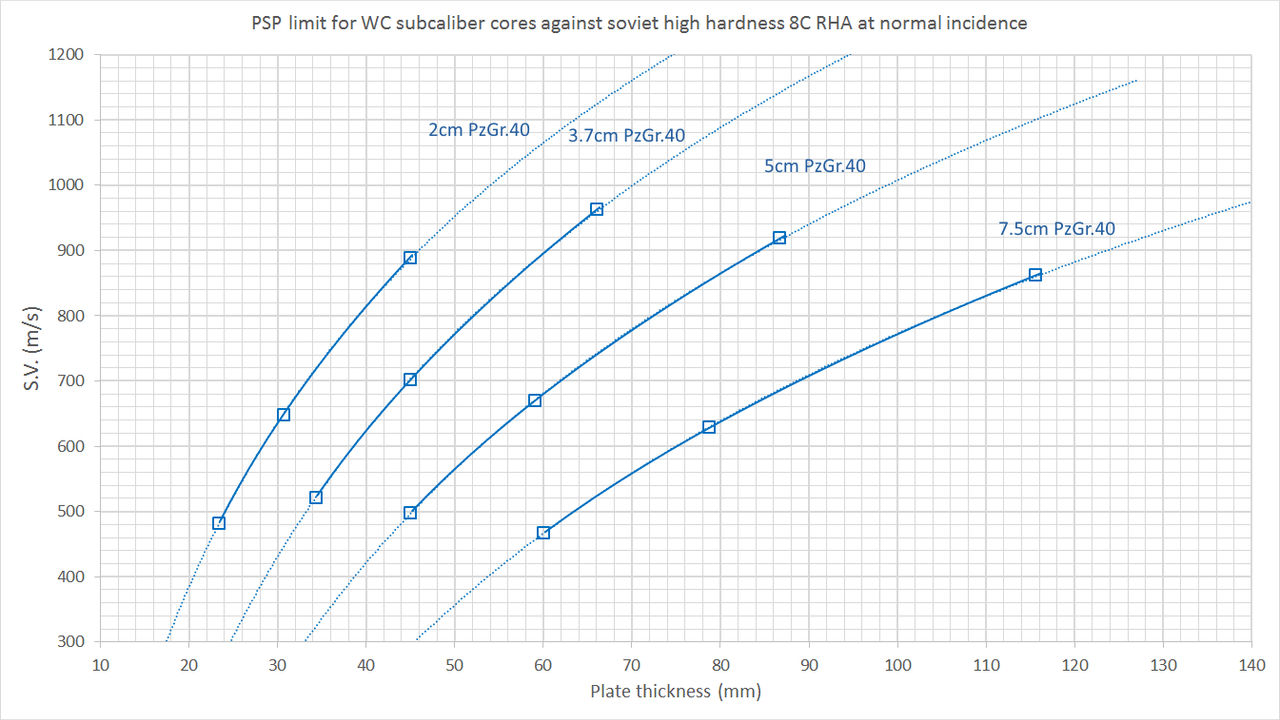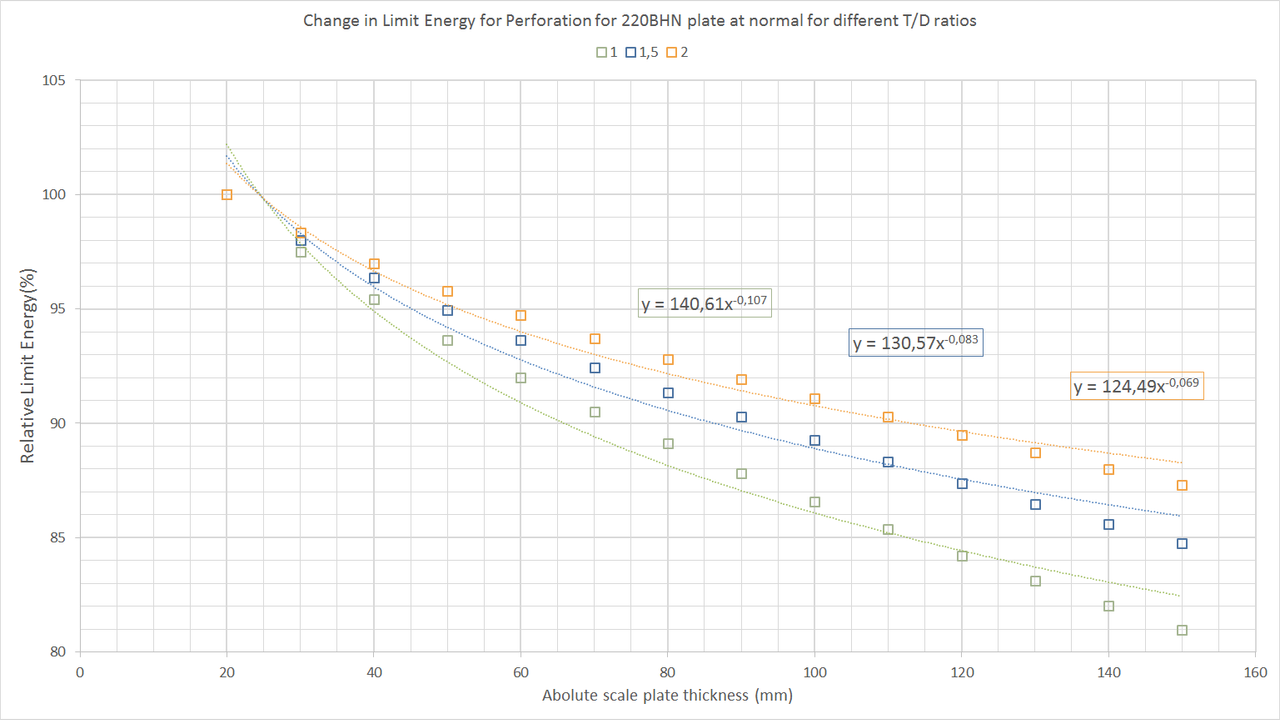The Russians test the Pak 38 and its PzGr 39
Re: The Russians test the Pak 38 and its PzGr 39
I feel like we are missing a part of the picture by evaluating performance of the soviet domestic armour tested in these trials using only one metric: the limit velocity at fixed obliquity. The germans themselves thought that another variable: the critical angle for protection/perforation, can be as important, if not more, than critical velocity as a judge of plate protective quality.
Here I'm comparing the estimated minimum obliquity vs perforation for shells of the same mass and caliber as the german 5cm and 3.7cm AP using formula created by the UK NPL from testing british domestic shot vs plate. It can be found here.
As you can see, the critical obliquity for 35mm HHA is 35-50° compared to the expected 40-45(?)° vs MQ RHA, overall neither is clearly superior.
Against 45mm of HHA its 20-37,5° vs 30-40° expected against MQ RHA, here the HHA is better.
45mm plates made from HHA seems to be strictly worse at resisting oblique impact from 50mm AP shells, not only by PSP angles, but I would immagine that the PTP angles are bigger than they would've been against MQ RHA as well.
60mm plates made for this test seems to be roughly on par with good quality british RHA when under attack from 37 and 50mm german AP shells.
Here I'm comparing the estimated minimum obliquity vs perforation for shells of the same mass and caliber as the german 5cm and 3.7cm AP using formula created by the UK NPL from testing british domestic shot vs plate. It can be found here.
As you can see, the critical obliquity for 35mm HHA is 35-50° compared to the expected 40-45(?)° vs MQ RHA, overall neither is clearly superior.
Against 45mm of HHA its 20-37,5° vs 30-40° expected against MQ RHA, here the HHA is better.
45mm plates made from HHA seems to be strictly worse at resisting oblique impact from 50mm AP shells, not only by PSP angles, but I would immagine that the PTP angles are bigger than they would've been against MQ RHA as well.
60mm plates made for this test seems to be roughly on par with good quality british RHA when under attack from 37 and 50mm german AP shells.
Re: The Russians test the Pak 38 and its PzGr 39
it has just occurred to me that the 5cm Pzgr.39 might experience shatter when impacting against soviet high hardness armour at high velocities, much above the ballistic limit. Maybe not against a vertical 45mm thick plate but against one at low to intermediate obliquity(20-40°). At this t/d ratio (0,9) the nose shatter probably wont prevent the perforation, but will likely prevent it penetrating in condition fit to burst. What do you think?
Re: The Russians test the Pak 38 and its PzGr 39
I've assembled in one chart my estimates on the performance of soviet HH-RHA vs tungsten carbide cores based on the data obtained in testing by the soviets (TsAMO 38_11355_817).


-
critical mass
- Member
- Posts: 740
- Joined: 13 Jun 2017, 15:53
- Location: central Europe
Re: The Russians test the Pak 38 and its PzGr 39
This is quiete possible, at least for thick sections of HHA like 75mm turret side wall elements, where the scaling effects associated with HHA works to the plates advantage over the 50mm projectile.Peasant wrote: ↑25 Jul 2021, 13:57it has just occurred to me that the 5cm Pzgr.39 might experience shatter when impacting against soviet high hardness armour at high velocities, much above the ballistic limit. Maybe not against a vertical 45mm thick plate but against one at low to intermediate obliquity(20-40°). At this t/d ratio (0,9) the nose shatter probably wont prevent the perforation, but will likely prevent it penetrating in condition fit to burst. What do you think?
Re: The Russians test the Pak 38 and its PzGr 39
The UK NPL formula output also indicates the presence of a scaling effect, albeit one dependent on the exact T/D ratio of the plate/penetrator.
My interpretation of this is that this effect arises mostly from interaction between the shell and the front/rear face of the plate as the change is smaller across different scales for high T/D ratios.

-
critical mass
- Member
- Posts: 740
- Joined: 13 Jun 2017, 15:53
- Location: central Europe
Re: The Russians test the Pak 38 and its PzGr 39
Just to add a caveate: This scaling effect is dependent upon obliquity, too. Normal impact scaling is positive at normal and negative at high obliquity.
Re: The Russians test the Pak 38 and its PzGr 39
the longer time of interaction with the plate appears as the reason for negative scaling at larger angles of incidence.critical mass wrote: ↑18 Sep 2021, 10:42Just to add a caveate: This scaling effect is dependent upon obliquity, too. Normal impact scaling is positive at normal and negative at high obliquity.
"Meine Herren, es kann ein siebenjähriger, es kann ein dreißigjähriger Krieg werden – und wehe dem, der zuerst die Lunte in das Pulverfaß schleudert!"
Re: The Russians test the Pak 38 and its PzGr 39
If anyone follows the YouTube channel Military History Visualized he just made a video on the Kubleblitz. This had twin 3 cm auto cannons. Apparently the AP shell was APCR. I did a video on this projectile. It had a Tungsten-carbide core the same dimensions as that used in the 3.7 cm APCR. Which gave it better ballistics than the 3,7 cm APCR or the 20mm ShVAK cannon.
Re: The Russians test the Pak 38 and its PzGr 39
I believe you accidentally a word here, Mobius.Mobius wrote: ↑14 Oct 2021, 16:22If anyone follows the YouTube channel Military History Visualized he just made a video on the Kubleblitz. This had twin 3 cm auto cannons. Apparently the AP shell was APCR. I did a video on this projectile. It had a Tungsten-carbide core the same dimensions as that used in the 3.7 cm APCR. Which gave it better ballistics than the 3,7 cm APCR or the 20mm ShVAK cannon.
Re: The Russians test the Pak 38 and its PzGr 39
Oh, yeah Kugelblitz. Here is a striking velocity graph of 3.7 cm APCR 3 cm APCR and 20mm ShVAKPeasant wrote: ↑14 Oct 2021, 18:13I believe you accidentally a word here, Mobius.Mobius wrote: ↑14 Oct 2021, 16:22If anyone follows the YouTube channel Military History Visualized he just made a video on the Kubleblitz. This had twin 3 cm auto cannons. Apparently the AP shell was APCR. I did a video on this projectile. It had a Tungsten-carbide core the same dimensions as that used in the 3.7 cm APCR. Which gave it better ballistics than the 3,7 cm APCR or the 20mm ShVAK cannon.
Re: The Russians test the Pak 38 and its PzGr 39
It is interesting to see how tests performed by the soviets confirm the figures given in german documents:


Re: The Russians test the Pak 38 and its PzGr 39
A close look at german 5cm PzGr.39 against soviet high hardness RHA.
Re: The Russians test the Pak 38 and its PzGr 39
H.Dv.Nr. 469 3b PzAbwehr aller Waffen Panzerjäger Stand 15.2.1943 state no Durchschlag at any distance of the T34 glacis plate
If one looks at the Bericht 166 der Lilienthalgesellschaft, according to the published obliquity function on page 98 in connection with Durchschlagsgraf of the improved Pzgr 39 the expected penetration of 45 mm armor at 30 degrees obliquity at ~700 m/s appears in the order of ~42 mm(+-).
I would classify this result into the zone of possibly mixed results. A Durchschlag (projectile trough plate) may occur or not depending on individual quality of armour/projectile combination. its surely not a black white situation.
and im not sure if the improved projectile breaks up at this velocity.
the older model Pzgr 39 had a max harding at the tip up to about 57-59 Rc
whereas the improved shell was hardened up to ~RC 63.
If one looks at the Bericht 166 der Lilienthalgesellschaft, according to the published obliquity function on page 98 in connection with Durchschlagsgraf of the improved Pzgr 39 the expected penetration of 45 mm armor at 30 degrees obliquity at ~700 m/s appears in the order of ~42 mm(+-).
I would classify this result into the zone of possibly mixed results. A Durchschlag (projectile trough plate) may occur or not depending on individual quality of armour/projectile combination. its surely not a black white situation.
and im not sure if the improved projectile breaks up at this velocity.
the older model Pzgr 39 had a max harding at the tip up to about 57-59 Rc
whereas the improved shell was hardened up to ~RC 63.
"Meine Herren, es kann ein siebenjähriger, es kann ein dreißigjähriger Krieg werden – und wehe dem, der zuerst die Lunte in das Pulverfaß schleudert!"
Re: The Russians test the Pak 38 and its PzGr 39
Well, considering that 3.7 and 5cm fire remained one of the main causes of Soviet armour losses deep into 42, this would be an understatement.I would classify this result into the zone of possibly mixed results
Re: The Russians test the Pak 38 and its PzGr 39
The safety curves posted previously indicate that 80mm of german RHA should provide immunity against the 5cm PzGr.39 (w/o it's AP cap) at s.v. of up to 866m/s. I estimate that the perforation limit would be ~900m/s. This results in the DeMarre K of 2455. Using this value I estimate that a 75mm thick RHA plate would be safe from the 5cm PzGr. (uncapped) at striking angles of at least 20° at 50m distance (821m/s) and from 793m/s at 0° which is almost exactly 150m distance. I'm myself surprised how well it all fits with these testing results (rows 3 and 4).
